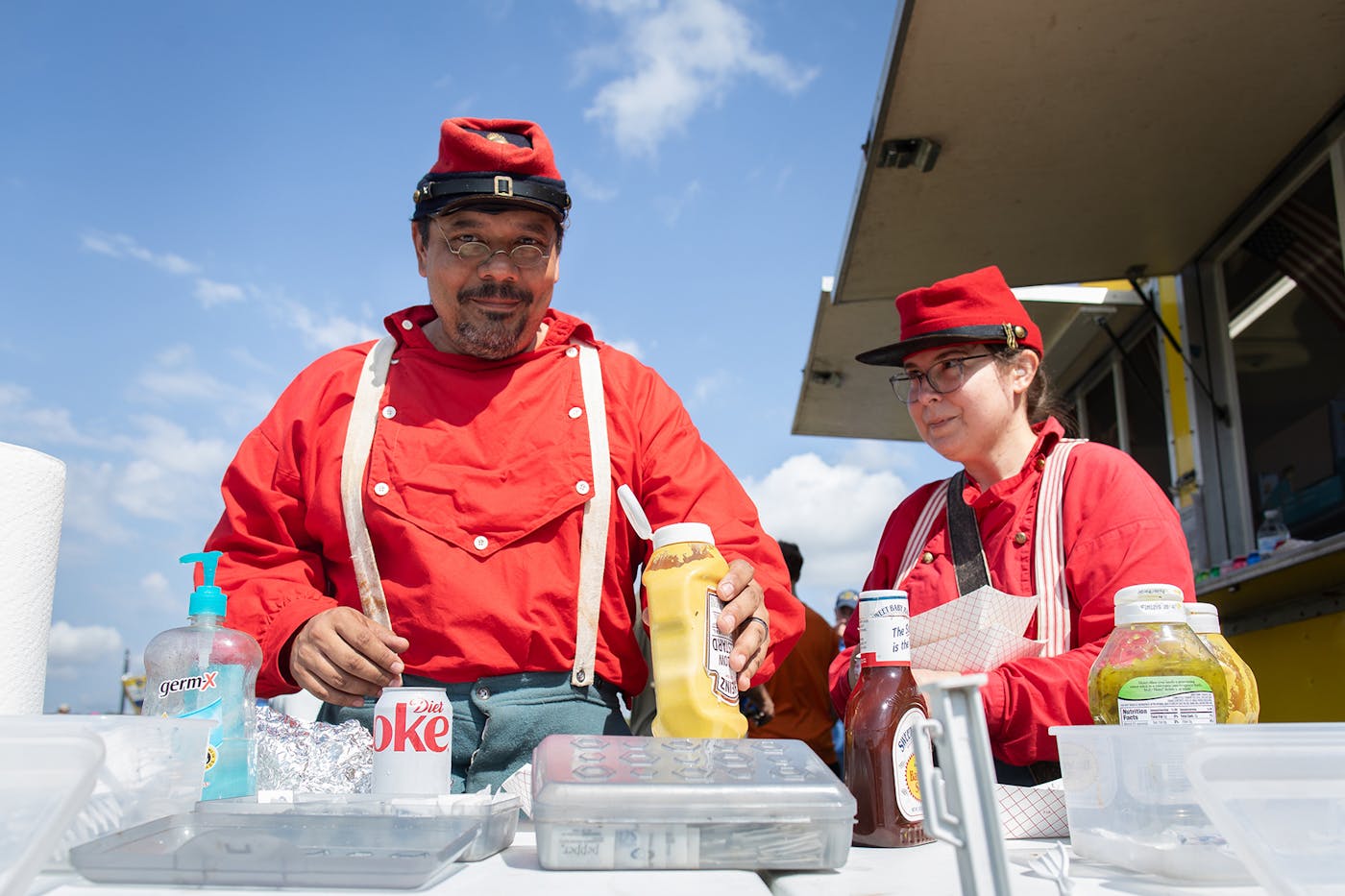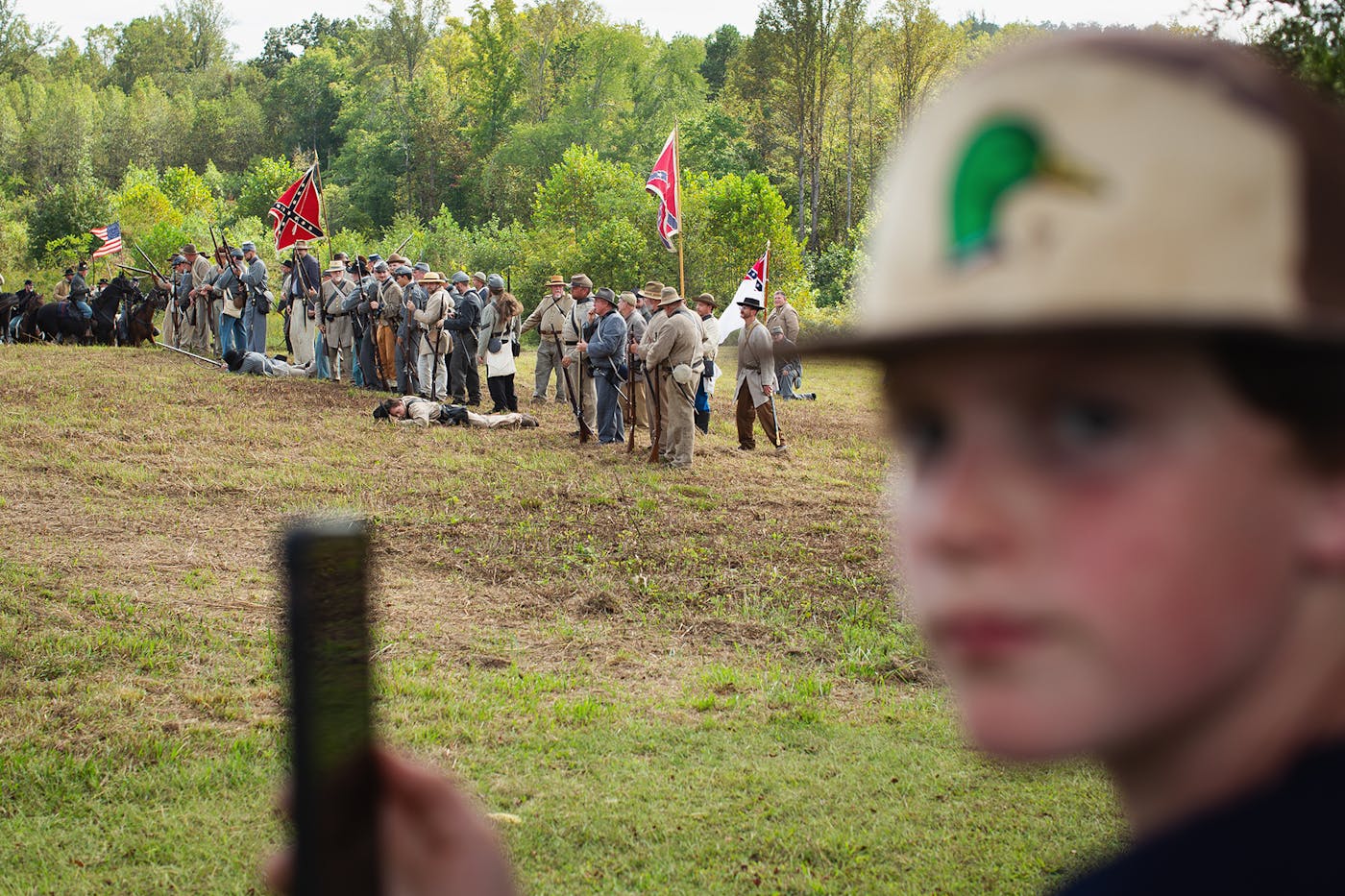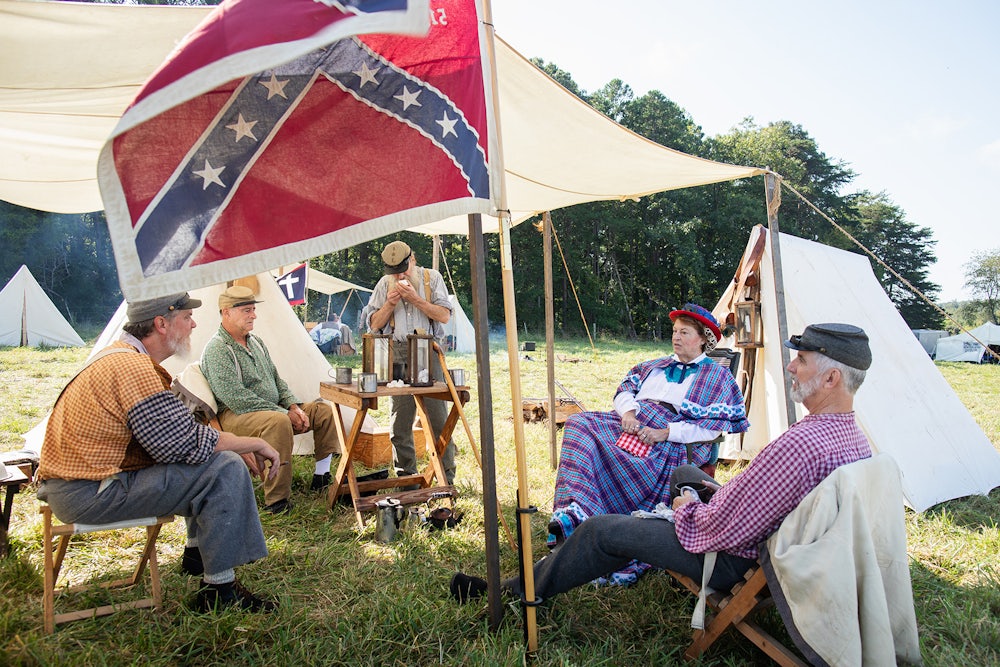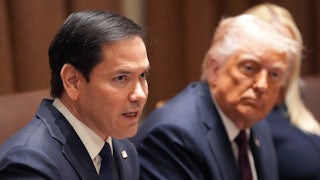On the last day of summer, in central Virginia, a battalion of Confederate soldiers marches in orderly ranks onto the field sloping down to Sailor’s Creek. A smaller force of Federals already holds the high ground. Sweating through the thick wool of their uniforms, the Confederates split to protect their left flank against the threat of cavalry. Once in position, everyone, blue and gray alike, freezes. The Confederate sergeants look to General Shelton. He has drawn up this scenario, and he will decide who takes the first shot.
I have come to Sailor’s Creek Battlefield Historic State Park, roughly 60 miles west of Richmond, to learn why so many people spend their weekends in Confederate uniforms reenacting the Civil War. How much, I wanted to know, does this hobby reflect a passion for history, and how much is it a manifestation of the militant turn of American politics? Would I encounter antebellum nostalgia or even outright denial of slavery’s role in the war?
Instead, I found a different—but no less insidious—threat to the health of American democracy.
Early in the morning, when I wandered around the Confederate camp, the devotion to recreating the physical conditions of the past was everywhere. Men sat around a campfire smoking pipes and watching a spit pig roast over the flames. Women in camp dresses and felt hats rearranged cast iron cookware in wicker baskets. A small dog napped in the shade of a weathered Confederate flag.
To be accepted here, one must avoid “being farby”—that is, letting anachronisms slip into camp. But not being farby is expensive. Over in the sutler’s tent, a pair of brogans will set you back nearly $100. A mess kit costs the same. A period rifle can run $2,000—if you can get one at all, I was told, since the primary supplier is distracted with making weapons for the war in Ukraine.
With these costs deterring a lot of would-be participants, Susie Meador, a reenactor in her sixties from Rocky Mount, Virginia, is in the business of recruitment. I hadn’t made a full pass through camp before she made her pitch to me. She gave two reasons why enlisting is worth the investment. First: It’s fun. For many people, she said, their reenactment family is more loving than their real family: “We come from all walks of life but keep our politics at home. We always try to remember why we’re here.”
Which was also her second reason to enlist: the power of education. “You need to know your history to see how it shapes you and the country in order to avoid the mistakes of the past,” she said. “I learn something every weekend I do this.”
All over camp, including from those still in their Trump T-shirts, I heard the same lessons: that compromise, statesmanship by moderate politicians, and adherence to the Constitution were the only means of preventing extremists from bringing the country to bloodshed.
But the most important lesson, I was told, was to understand what previous generations endured to create today’s America. “In reenacting we don’t suffer quite the hardships the soldiers did back then,” West Williams of the Federal cavalry told me over lemonade, “but we’re getting a taste.”

This educational mission was not just for the benefit of the reenactors themselves; it was also for the spectators, who in late morning came to the battlefield by the busload. After a stop at the Lions Club food truck, families wandered around the camp asking questions and touching gear and trying out the rebel yell.
Of course, there are many periods in American history that could, through reenactment, serve a similar educational mission—including other wars. And yet, Civil War reenactment is significantly more popular than even Revolutionary War reenactment; in decline in the 2010s, it reportedly rebounded in 2020 in the wake of protests over the removal of Confederate statues and monuments. But throughout the weekend, many reenactors lamented that younger people were more interested in reenacting World War II.
Notably, everyone I saw at Sailor’s Creek, reenactor and spectator alike, was white.
I asked Ms. Meador why she thought Black people were uninterested in watching the battle that had secured the South’s defeat. “Everything goes back to slavery,” she said. “People can’t get slavery out of their minds, so they think we’re here trying to bring something bad back.”
Again and again, reenactors spoke of how frustrating it was to be called a racist for a hobby they saw as apolitical—no different than working at Colonial Williamsburg or being an extra in a Civil War movie (which many of these men had done). Assuming reenactors were racist was like assuming a participant at the Renaissance fair wanted to reestablish feudal property relations.
After lunch, the spectators left camp: It was time for war. The Confederate Army marched in uneven files down a wide, paved road. After a quarter mile, the companies turned left onto a grassy path by the creek. The men waited under the trees until the Federals could get in position. General Shelton lay down on the side of the path to rest his feet and smoke a Camel.
Nervous before combat, the infantry got chatty and revealed deep knowledge of Civil War history. “Of course the war was about slavery,” Confederate Sergeant Matthew Connor said. “Read any state secession document. You’ll see in the first line it was about slavery.” A man in his company complained around his chaw that the war had been government as usual: poor men dying for the 1 percent. Not one man denied that the war was about slavery or voiced any of the other Lost Cause lies.
But what I was not prepared for were the end-times fear and pessimism that pervaded the ranks. The soldiers were in complete agreement that war was coming. Not in a few minutes, in reenactment, but in real life, in America, and in my lifetime. What the men could not agree on was the cause. One feared an A.I.-driven war, another the consequences of draining the aquifer in the Southwest. Another soldier fixated on how much land had been given over to growing animal feed—and feared what Americans would do to stay fed when the soil was depleted. Climate change wars loomed particularly large in their imaginations.
When I asked if they’d learned anything in their study of the Civil War that could help prevent the next war, they said it was a foregone conclusion. Politicians were all too corrupt to get anything done, the soldiers insisted, and then changed the subject.
The battle started with artillery fire from the southern hill. The opposing infantries loaded their rifles, fired, walked backwards ten yards. The opposing cavalries approached each other, locked eyes, tapped swords. “Slow it down, gentlemen!” an officer called. Spectators checked their phones. The park policeman filmed from his golf cart.

History did not come to life for me until my afternoon tour of Hillsman House, the eighteenth-century home at the center of the park. At the start of the real battle, the Hillsman family had cowered in the basement while the armies fought overhead. The Confederates had converted the house into a field hospital until the Federals commandeered it to treat their own men. Before long, limbs had been stacked up to the window like firewood.
A century and a half later, the floor was still stained with blood, particularly where it had pooled around the surgeon’s feet. In what had been the patient recovery room hung a portrait of Robert Russa Moton, a local civil rights leader whose mother had been enslaved at the farm at the time of the battle. It was the only anachronism at the reenactment that gestured toward inclusivity.
Instead, all weekend long I saw reenactors being farby in ways that made life more comfortable for themselves. While the battle still raged, women in period dress ladled ice to the fallen to protect against the heat. After the fighting, a Pepsi was left on hallowed ground. In camp, a lifted tent flap showed an air mattress. A plate of golden croissants sat on an old-fashioned stool.
But even more incongruous was the idea that reenacting the Civil War could be fun. Not only had the war been unimaginably horrific, but also—as the reenactors reminded me over and over—its consequences were still shaping contemporary America and its broken politics. While everyone involved agreed that less extreme politicians were required to heal the nation’s wounds, they could see no role for themselves to play in that process. Which meant there was no reason not to have fun today, waging fake war as long as peace prevailed.
But if the reenactment was based on a fantasy of political powerlessness, the camaraderie built upon it was real. Next morning, camp had a solemn air. There was to be a memorial service for K. Wayne Gowin, a founding member of this corps who had died in late August. His widow and daughter were in attendance for a service that would not follow any military protocol: Surviving corps leadership had conceived it from whole cloth.
After parade, the battalion marched out to a lone cannon in the middle of the field where a team of gunners stood ready. General Shelton said a few kind words. At the signal, a gunner by the cannon yanked a string. The boom was incredible, but all that came out was a small, stinking cloud over the heads of men who had spent their money and creative energy turning themselves into men of the past. Soon they were dismissed.






